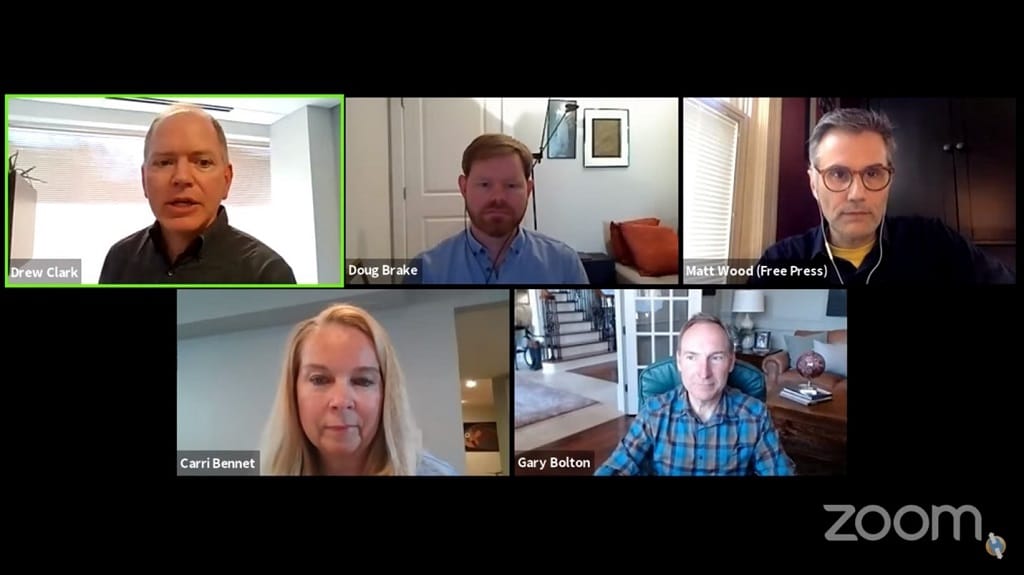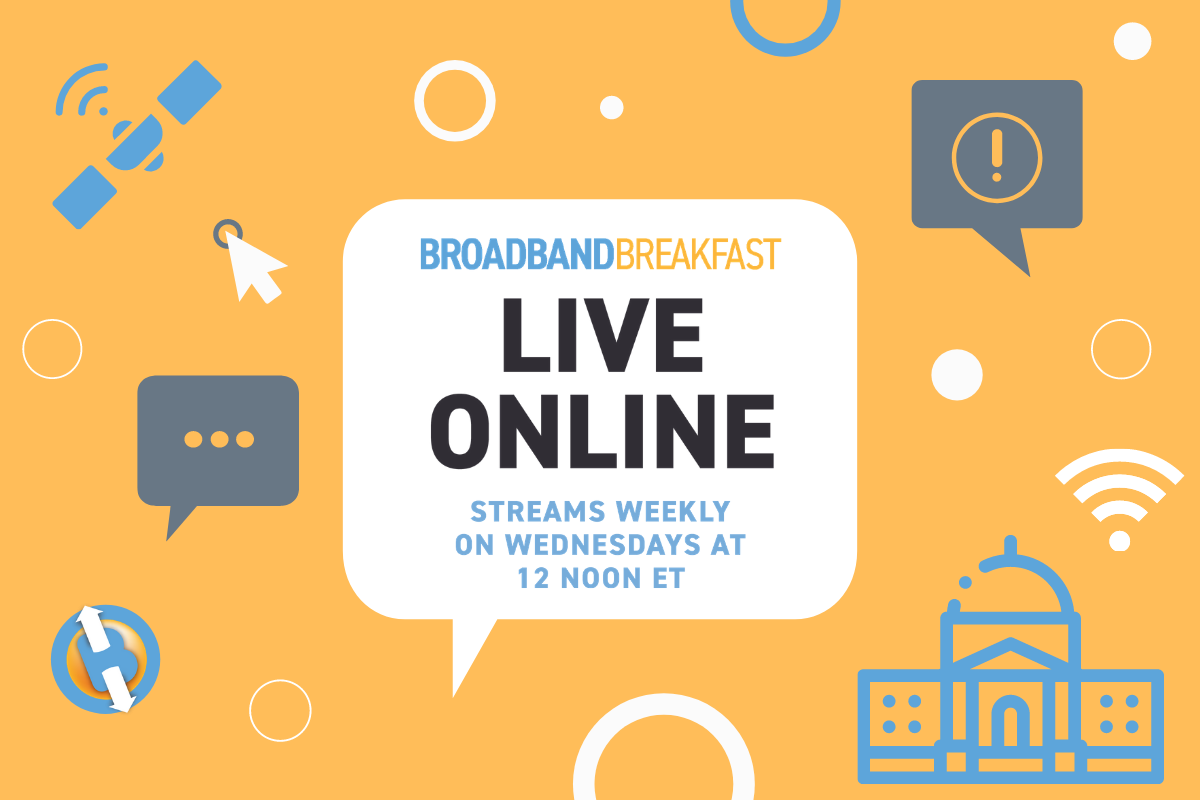Experts Weigh What Future Of Broadband Could Look Like Under Biden’s Infrastructure Plan
Experts at the Broadband Breakfast Live Online event debated what “future-proofing” broadband would look like.

April 8, 2021 – Experts in Wednesday’s Broadband Breakfast Live Online event debated what “future-proofing” broadband could look like and whether President Joe Biden’s infrastructure plan can achieve it.
The White House’s new “American Jobs Plan” looks to fund $100 billion for broadband infrastructure in addition to other areas, and part of that plan “prioritizes building ‘future proof’ broadband infrastructure in unserved and underserved areas so that we finally reach 100 percent high-speed broadband coverage,” said a White House statement.
Carri Bennet, general counsel for the Rural Wireless Association, said at Wednesday’s event that fiber is essential for all types of networks. “We do mobile wireless, we do fixed wireless, we use all sorts of spectrum in our toolkit, and all of these wireless networks are connected to fiber at some point, somewhere,” she said.
But Bennet also said there are exciting developments for wireless that is not specifically fiber. “There are a lot of exciting things going on in the wireless world right now that could future-proof networks,” she said. “That’s using software and virtualized networks so that you don’t have to change out hardware on antennas on towers anymore.”
Open radio access networks (Open RAN) are such systems, which use open protocol wireless technologies that prevent the industry from relying on proprietary supplies generated by few companies. Bennet said open RAN is showing promise.
Sen. Mark Warner, D-Virginia, led a bipartisan effort Tuesday requesting $3 billion in Open RAN technology funding for the Biden administration’s annual budget request.
Doug Brake, director of broadband policy at the think tank Information Technology and Innovation Foundation, said Wednesday he believes the policy needs to technology neutral.
Legislation should be flexible to allow the best solutions for an area that are needed, he said. When ‘future proofing’ comes up, he said he is worried that fiber and cable become the focus. While fiber is really important to getting many unserved areas connected, we shouldn’t lock ourselves into a single tool — we want the flexibility to solve the problem as its needed, he said.
Municipal versus private broadband
Brake also expressed concern that Biden’s plan would prioritize funds for local municipal and co-op broadband.
“We really need to leverage our private providers, particularly private providers that have large economies that scale,” he said. While municipalities and co-ops are great at filling needed gaps, “they don’t scale well outside the jurisdiction, they don’t invest in [research and development] to develop new access technologies; they don’t contribute to standards,” he said.
But Gary Bolton, CEO of the Fiber Broadband Association, said Wednesday that, “We’ve seen first-hand the significant benefits and significant economic impact that fiber has when it’s deployed in communities,”. He referenced Chattanooga, Tennessee, the first city in America where gigabit-speed internet was offered in 2010. The city developed a municipally-owned fiber network that, according to a 2020 study by Bento Lobo at the University of Tennessee at Chattanooga, saw considerable return over the 10 years since its deployment.
“Fiber also delivers remote healthcare, online learning, public safety and provides a path for future services like 5G,” Bolton said.
On broadband affordability
Affordability is another piece of the broadband puzzle, and Biden’s proposal also seeks to address long-term cost issues. In a statement, the White House acknowledged the need for some short-term subsidies, but said that “continually providing subsidies to cover the cost of overpriced internet service is not the right long-term solution for consumers or taxpayers.”

Everyone needs to be able to afford broadband, Matt Wood, vice president of policy and general counsel at the advocacy organization Free Press, said Wednesday. “We want to talk about affordability and adoption, and we’ve done that in the mapping context, we’ve done it here, and I think that’s why this plan is so exciting to us,” he said.
Funding programs like the Emergency Broadband Benefit, and the focus on affordability and adoption in Rep. Jim Clyburn’s bill and the LIFT America Act are key, he said. This is not one of those, “if you build it, they will come” situations, he said. Building “fabulous networks” in rural and urban areas that people can’t afford to use should not be the infrastructure goal, he said.
Bolton expressed support for Biden’s proposal to address long-term affordability issues, but he wants to see funding done well. “It pains me to see so much precious stimulus money going to subsidize ridiculously expensive, poor-performing broadband such as satellite in rural areas,” he said.
The details of the American Jobs Plan are still being developed, and the White House is discussing those details with a variety of members of the broadband industry, according to Bolton.
Our Broadband Breakfast Live Online events take place every Wednesday at 12 Noon ET. You can watch the April 7, 2021, event on this page. You can also PARTICIPATE in the current Broadband Breakfast Live Online event. REGISTER HERE.

Wednesday, April 7, 2021, 12 Noon ET — “Billions and Billions: How to Spend Broadband Infrastructure”
On the heels of the Biden Administration’s unveiling of the American Jobs Plan, Broadband Breakfast will convene a special Broadband Breakfast Live Online event to take the pulse of the broadband industry on the core components of the administration plan:
- Build high-speed broadband infrastructure to reach 100 percent coverage. The administration’s plan prioritizes building “future proof” broadband infrastructure in unserved and underserved areas so that we finally reach 100 percent high-speed broadband coverage.
- Promote transparency and competition. President Biden’s plan will promote price transparency and competition among internet providers, including by lifting barriers that prevent municipally-owned or affiliated providers and rural electric co-ops from competing on an even playing field with private providers, and requiring internet providers to clearly disclose the prices they charge.
- Reduce the cost of broadband internet service and promote more widespread adoption.
This measure is expected to allocate $100 billion for broadband infrastructure and adoption. This panel will consider and discuss the broadband parameters of the Biden plan.
Panelists:
- Doug Brake, Director of Broadband and Spectrum Policy, Information Technology and Innovation Foundation (ITIF)
- Gary Bolton, President and CEO, the Fiber Broadband Association (FBA)
- Matt Wood, Vice President of Policy and General Counsel, Free Press
- Carri Bennet, Partner at Womble Bond Dickinson (US) LLP
- Drew Clark (moderator), Editor and Publisher, Broadband Breakfast

Doug Brake directs the Information Technology and Innovation Foundation’s work on broadband and spectrum policy. He writes extensively and speaks frequently to lawmakers, the news media, and other influential audiences on topics such as next-generation wireless, rural broadband infrastructure, and network neutrality. Brake is a recognized broadband policy expert, having testified numerous times before Congress, state legislatures, and regulatory commissions, as well as serving on the FCC’s Broadband Deployment Advisory Group.
Gary Bolton serves as president and CEO of the Fiber Broadband Association — the largest trade association in the Americas dedicated to all-fiber-optic broadband. With more than three decades in the telecom industry, Bolton joined the Fiber Broadband Association as president and CEO in 2020 after serving on the association’s board as vice chairman, treasurer and vice chairs of public policy and marketing committees. Prior to taking the leadership role at the Fiber Broadband Association, he spent 11 years at ADTRAN serving as vice president of global marketing and government affairs.
Matt Wood currently serves as Vice President of Policy and General Counsel at Free Press, where he helps shape the policy team’s efforts to protect the open internet, prevent media concentration, promote affordable broadband deployment and safeguard press freedom. Before joining Free Press, he worked at the public interest law firm Media Access Project and in the communications practice groups of two private law firms in Washington, D.C. He has also served as an expert witness before Congress on multiple occasions.
Carri Bennet is an outspoken advocate for small rural carriers, having battled with regulators and large companies for more than 30 years to ensure that small rural businesses have a seat at the table and a strong voice in Washington, DC. Bennet launched her own successful boutique communications and technology law firm prior to joining Womble Bond Dickinson in its Washington, DC office, and she also serves as outside counsel for the Rural Wireless Association and earlier as General Counsel and de facto chief operating officer of an international wireless carrier. She represents her clients before the FCC, state regulatory agencies, the courts and Congress, and she regularly testifies before the FCC, Congress and the courts on rural wireless issues and speaks regularly at industry trade shows and legal seminars on cybersecurity, data privacy, spectrum policy, universal service funding reform, and business development and strategy issues for communications and technology companies.
WATCH HERE, or on YouTube, Twitter and Facebook.

As with all Broadband Breakfast Live Online events, the FREE webcasts will take place at 12 Noon ET on Wednesday.
SUBSCRIBE to the Broadband Breakfast YouTube channel. That way, you will be notified when events go live. Watch on YouTube, Twitter and Facebook.
See a complete list of upcoming and past Broadband Breakfast Live Online events.









Member discussion